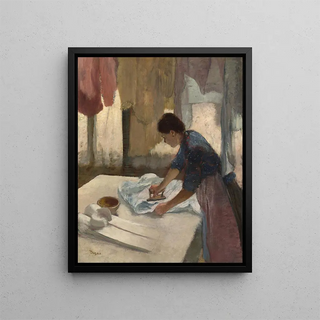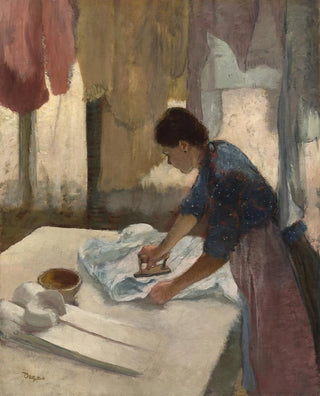Art print | Woman ironing - Edgar Degas


View from behind

Frame (optional)
Femme Repassant - Edgar Degas – Captivating Introduction
In the intimacy of a home, the artwork "Femme repassant" by Edgar Degas stands out as a true tableau of life, capturing the very essence of everyday moments with rare delicacy. This scene, imbued with realism and poetry, immerses us in the world of women at the end of the 19th century, a time when the depiction of domestic life became a privileged subject for artists. With a touch of Impressionism, Degas immortalizes a fleeting moment, where the woman, absorbed in her activity, appears both present and distant, as if she were a reflection of a rapidly changing era. This piece, both simple and complex, invites us to explore the dynamics of gender, class, and art itself.
Style and uniqueness of the work
Edgar Degas's style is distinguished by his innovative approach to composition and light. In "Femme repassant," the artist employs unexpected angles and bold framing that break away from traditional academic conventions. The posture of the woman, bent over her task, is rendered with impressive precision, emphasizing the tension between physical effort and the apparent serenity of the scene. The colors, though subtle, are carefully chosen to evoke the warmth of a home, while the interplay of shadows and light creates an intimate atmosphere. Degas manages to transcend the banality of everyday gestures to turn them into works of art, revealing the hidden beauty in the simplest actions. This ability to capture the essence of movement and emotion is what makes his work so unique and timeless.
The artist and his influence
Edgar Degas, an emblematic figure of the Impressionist movement, established himself as a master of depicting the human body and scenes of daily life. Although he distanced himself from the conventions of his time, his work is not limited to simple Impressionist classification. On the contrary, he combines refined technique with modern sensitivity, exploring themes such as dance, ballet, and domestic life. His fascination with movement and time allowed him to create

Matte finish

View from behind

Frame (optional)
Femme Repassant - Edgar Degas – Captivating Introduction
In the intimacy of a home, the artwork "Femme repassant" by Edgar Degas stands out as a true tableau of life, capturing the very essence of everyday moments with rare delicacy. This scene, imbued with realism and poetry, immerses us in the world of women at the end of the 19th century, a time when the depiction of domestic life became a privileged subject for artists. With a touch of Impressionism, Degas immortalizes a fleeting moment, where the woman, absorbed in her activity, appears both present and distant, as if she were a reflection of a rapidly changing era. This piece, both simple and complex, invites us to explore the dynamics of gender, class, and art itself.
Style and uniqueness of the work
Edgar Degas's style is distinguished by his innovative approach to composition and light. In "Femme repassant," the artist employs unexpected angles and bold framing that break away from traditional academic conventions. The posture of the woman, bent over her task, is rendered with impressive precision, emphasizing the tension between physical effort and the apparent serenity of the scene. The colors, though subtle, are carefully chosen to evoke the warmth of a home, while the interplay of shadows and light creates an intimate atmosphere. Degas manages to transcend the banality of everyday gestures to turn them into works of art, revealing the hidden beauty in the simplest actions. This ability to capture the essence of movement and emotion is what makes his work so unique and timeless.
The artist and his influence
Edgar Degas, an emblematic figure of the Impressionist movement, established himself as a master of depicting the human body and scenes of daily life. Although he distanced himself from the conventions of his time, his work is not limited to simple Impressionist classification. On the contrary, he combines refined technique with modern sensitivity, exploring themes such as dance, ballet, and domestic life. His fascination with movement and time allowed him to create






